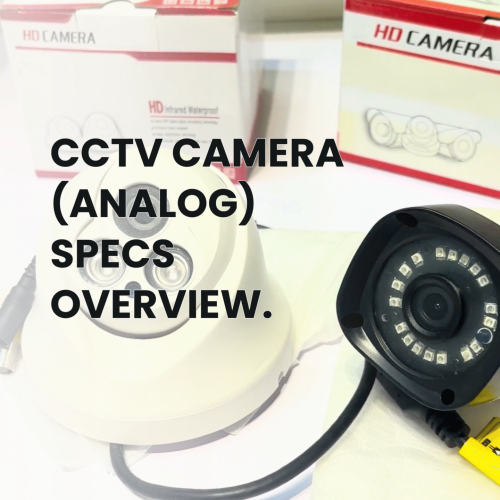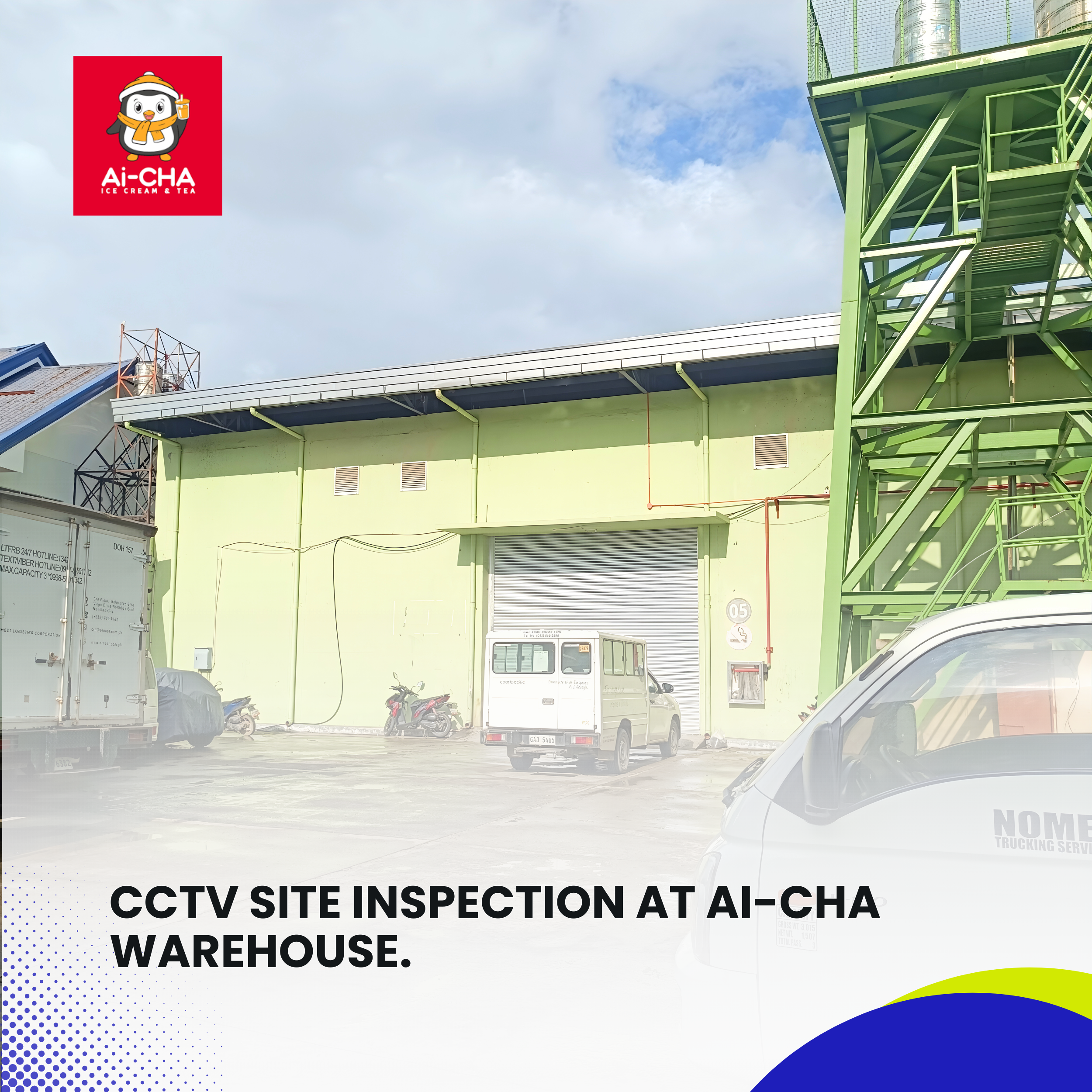Structured Cabling Supply and Installation at Secret Paradise, Palawan — First Progress Update. Introduction The Intercom System Installation Project officially began its first major phase with the start of piping implementation on …
CCTV Camera (Analog) Specs Overview.

Introduction.
In today’s security-conscious world, businesses, homeowners, and institutions understand the importance of reliable surveillance systems. Among the various technologies available, analog CCTV cameras remain a popular choice for many clients due to their cost-effectiveness, simplicity, and proven track record. While digital IP-based systems are now common in high-end installations, analog cameras still provide excellent performance, especially for small to medium-sized setups that require dependable monitoring without the higher costs of advanced networking infrastructure.
This article explores the specifications, features, and key components of analog CCTV cameras. It will also highlight the differences between popular camera types such as dome and bullet designs, discuss resolution capabilities, and explain supporting equipment like power supplies and DVRs. Additionally, it underscores how expert installation services—such as those provided by InstallersPH IT Solutions—can ensure optimal performance and long-term reliability.
Product Video.
1. Understanding Analog CCTV Cameras.
Analog CCTV cameras capture video signals in a traditional format and transmit the footage through coaxial cables to a recording device or monitor. Unlike network-based IP cameras, analog cameras convert images into an analog video signal, which the DVR digitizes for storage and playback. This process makes them a straightforward solution that doesn’t require complex networking knowledge or expensive hardware.
These cameras are particularly valued in small offices, retail shops, residential properties, and budget-conscious projects. Their ease of setup, combined with the availability of affordable replacement parts and accessories, ensures that analog CCTV systems remain competitive in the surveillance market.
2. Camera Types and Features.
A. Dome Cameras
Dome cameras are among the most common types of analog CCTV devices, known for their compact and tamper-resistant design. As the name suggests, they are encased in a dome-shaped housing that not only protects the lens but also conceals the camera’s direction.
Key features of dome cameras include:
Indoor Suitability: Dome cameras are primarily used indoors, such as in offices, retail stores, and residential hallways. Their discreet appearance allows them to blend seamlessly into ceilings or walls without drawing attention.
Tamper Protection: The protective dome casing helps prevent unauthorized interference or tampering.
Aesthetic Appeal: Their low-profile design makes them visually less intrusive, which is ideal for environments where appearance matters.
Wide Viewing Angles: Many dome cameras offer a wide field of view, making them excellent for monitoring larger indoor spaces with fewer units.
B. Bullet Cameras
Bullet cameras are designed for outdoor use, where durability and visibility are critical. Their long, cylindrical housings make them easy to spot, which can act as a deterrent to potential intruders.
Key features of bullet cameras include:
Weatherproof Design: Bullet cameras typically feature weather-resistant casings rated for rain, dust, and other harsh conditions. This makes them ideal for parking lots, building exteriors, and perimeter security.
Infrared LEDs: Many bullet cameras are equipped with infrared (IR) LEDs that provide night vision capabilities, ensuring reliable performance even in complete darkness.
Longer Range Monitoring: Bullet cameras often have lenses optimized for long-distance viewing, making them suitable for monitoring driveways, gates, or expansive outdoor areas.
Deterrent Effect: Their visible design can discourage trespassers or thieves simply by being present.
3. Resolution Capabilities.
Resolution is a critical factor in determining the clarity of captured video. Analog CCTV systems have evolved significantly over the years, with modern options capable of delivering footage from standard definition (SD) to full high definition (HD).
Standard Definition (SD): Early analog cameras often offered SD resolution, which was sufficient for basic monitoring but lacked detail.
High Definition (HD) and Full HD (1080p): Today’s analog cameras can provide up to 1080p resolution, ensuring clear and detailed video. This improvement allows users to identify faces, license plates, and other important details, bridging much of the gap between analog and IP camera performance.
Cost-Effective Upgrades: For many users, upgrading to 1080p analog cameras is a more affordable alternative than transitioning to IP-based systems, especially when existing coaxial cabling is already in place.
4. System Components Supporting Analog Cameras.
A. Power Supply
Analog CCTV cameras typically operate on a 12V DC power supply, which is standard across most models. Power delivery can be managed in two primary ways:
Individual Power Adapters: Smaller systems with one or two cameras may use dedicated adapters for each camera. This method is simple and inexpensive but can become cumbersome in larger setups with multiple adapters and cables.
Centralized Power Distribution Boxes: For medium to large installations, centralized power boxes are the preferred solution. These units distribute power to several cameras from a single source, resulting in cleaner wiring, easier troubleshooting, and improved safety.
Proper power management is essential for stable camera performance. Using low-quality or mismatched power supplies can lead to video signal loss, flickering, or premature camera failure.
B. Digital Video Recorder (DVR)
The DVR is the heart of an analog CCTV system. It receives the analog video signals, converts them into a digital format, and stores the footage on a hard drive for later playback or export. Modern DVRs come equipped with advanced features that significantly enhance the functionality of analog cameras:
Motion Detection: DVRs can detect movement in a camera’s field of view and trigger recording only when activity occurs. This saves storage space and makes reviewing footage more efficient.
Recording Schedules: Users can set up recording schedules to capture video during specific hours, such as after business hours or on weekends.
Playback and Search: DVR interfaces allow for easy navigation through recorded footage. Events can be quickly located using timestamps or motion events.
Remote Viewing: Many DVRs offer network connectivity, enabling users to access live or recorded footage remotely via smartphones, tablets, or computers.
Expandable Storage: DVRs often support multiple hard drives or external storage options to accommodate extended recording times.
5. Advantages of Analog CCTV Systems.
Despite the growing popularity of IP-based solutions, analog CCTV systems continue to provide numerous benefits that make them an attractive choice for certain applications:
Affordability: Analog cameras and DVRs are generally less expensive than their IP counterparts, making them ideal for budget-conscious projects.
Ease of Installation: Analog systems use straightforward coaxial cabling and do not require network configuration, which simplifies setup for technicians and reduces installation time.
Reliability: Analog technology has been tested and proven over decades, offering consistent performance without the need for advanced networking expertise.
Compatibility: Many modern analog cameras are backward compatible with existing coaxial cabling, reducing upgrade costs for users who want to enhance their systems without replacing all infrastructure.
Lower Bandwidth Requirements: Since analog systems do not transmit video over IP networks, they do not consume network bandwidth, which is a consideration in environments with limited or heavily used networks.
6. Limitations of Analog CCTV Cameras.
While analog cameras are highly effective in many scenarios, they are not without limitations. Understanding these drawbacks helps clients make informed decisions:
Lower Maximum Resolution: Even at 1080p, analog cameras cannot match the ultra-high resolutions (4K and beyond) achievable with IP cameras.
Limited Advanced Features: IP systems often include advanced analytics such as facial recognition, license plate reading, and integration with smart security systems—features generally absent in analog setups.
Cable Length Constraints: Long cable runs may degrade signal quality unless signal boosters or higher-grade coaxial cables are used.
Scalability Challenges: Expanding an analog system requires additional cabling for each new camera, which can become cumbersome in very large installations.
7. Applications for Analog CCTV Cameras.
Analog CCTV cameras remain widely used across various industries and settings where cost, simplicity, and reliability take precedence:
Small Business Security: Retail shops, restaurants, and small offices often choose analog systems to monitor entrances, cash registers, and customer activity without excessive expense.
Residential Surveillance: Homeowners use dome or bullet cameras to secure property entrances, driveways, and backyards while maintaining a manageable budget.
Warehouses and Storage Facilities: Bullet cameras are especially effective for monitoring large outdoor areas and loading docks.
Schools and Community Centers: Analog systems provide affordable monitoring solutions to enhance safety in educational and public spaces.
8. Best Practices for Installation and Maintenance.
A. Planning the Layout
Before installation, conduct a site assessment to determine camera placement for optimal coverage. Avoid blind spots and consider lighting conditions, entry points, and critical areas such as safes or cash drawers.
B. Using Quality Cabling
Coaxial cables like RG59 or RG6 are standard for analog cameras. Use high-quality cables and connectors to ensure minimal signal loss and interference.
C. Power Considerations
If using a centralized power supply, ensure that the total power output meets the requirements of all connected cameras. For outdoor bullet cameras, consider surge protection to safeguard against power fluctuations.
D. DVR Configuration
Set recording schedules and motion detection settings according to security needs. Periodically check hard drive health and available storage to avoid unexpected recording interruptions.
E. Regular Maintenance
Clean camera lenses periodically to maintain clear images. Inspect cables for wear or damage, and test the system regularly to ensure all cameras and the DVR are functioning correctly.
9. Role of Professional Installation Services.
While analog CCTV systems are simpler to install compared to IP-based setups, professional services can make a significant difference in performance and reliability. Companies like InstallersPH IT Solutions specialize in designing and implementing security systems tailored to specific environments.
Professional installers provide:
Expert Camera Placement: Ensuring optimal coverage and eliminating blind spots.
Neat and Secure Wiring: Organizing cables for both aesthetic appeal and long-term durability.
System Optimization: Configuring DVR settings for motion detection, schedules, and remote access.
Ongoing Support: Offering troubleshooting, maintenance, and upgrades as technology evolves.
By leveraging professional expertise, businesses and homeowners can maximize the value of their analog CCTV investments while minimizing downtime or security gaps.
10. The Future of Analog CCTV Technology.
Analog CCTV systems have adapted over the years to stay relevant in a market dominated by IP solutions. Technologies such as HD-TVI, HD-CVI, and AHD (Analog High Definition) have extended the life of analog cameras by enabling higher resolutions and improved image quality while retaining compatibility with traditional coaxial cabling. These innovations ensure that analog cameras remain a viable option for many clients who prioritize affordability and simplicity.
Looking forward, hybrid systems that combine analog and IP cameras on the same DVR or NVR platform are becoming increasingly popular. Such systems allow gradual upgrades; organizations can start with existing analog cameras and slowly introduce IP units as budgets allow, ensuring a smooth transition without complete overhauls.
Conclusion.
Analog CCTV cameras continue to be a trusted choice for many security applications. Their affordability, reliability, and ease of use make them an excellent solution for small to medium installations where ultra-high resolution and advanced analytics are not essential. Dome cameras provide discreet indoor monitoring, while bullet cameras excel in outdoor environments with weatherproof housings and infrared night vision.
Supported by components like stable 12V DC power supplies and feature-rich DVRs, analog CCTV systems can deliver clear video footage up to 1080p. Businesses and homeowners who require dependable surveillance without high upfront costs will find analog cameras to be a practical and efficient choice.
With expert installation services from professionals such as InstallersPH IT Solutions, analog systems can be tailored to meet specific security needs and deliver long-term performance. As technology continues to evolve, analog CCTV cameras remain a cornerstone of modern surveillance, bridging the gap between affordability and effective security.
Case Studies
Starlink and Access Point Site Inspection at Tubod Flowing Water Resort. Introduction. In an increasingly connected world, internet connectivity plays a vital role in both business operations and guest experience. Recognizing the …
CCTV Site Inspection at Ai-CHA Warehouse. Introduction. In today’s business environment, security is a top priority—especially for facilities that store valuable goods and equipment. To enhance the safety and monitoring capabilities of …


